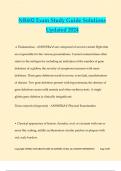NR602 Exam Study Guide Solutions
Updated 2024
α Thalassemias - ANSWER✔✔-are composed of several variant Hgbs that
are responsible for the various presentations. Current nomenclature often
refers to the subtypes by including an indication of the number of gene
deletions of α globin; the severity of symptoms increases with more
deletions. Three gene deletions result in severe, even fatal, manifestations
of disease. Two gene deletions present with hypochromia; the absence of
gene deletions causes mild anemia and often erythrocytosis. A single
globin gene deletion is clinically insignificant
Tinea corporis (ringworm) - ANSWER✔✔-Physical Examination
• Classical appearance of lesions: Annular, oval, or circinate with one or
more flat, scaling, mildly erythematous circular patches or plaques with
red, scaly borders
Copyright ©EMILLYCHARLOTE 2025 ACADEMIC YEAR, ALL RIGHTS RESERVED. Page 1/135
,• Lesions spread peripherally and clear centrally or may be inflammatory
throughout with superficial pustules
• Often prominent over hair follicles
• Multiple secondary lesions may merge into a large area several
centimeters in diameter
Myopia (nearsightedness) - ANSWER✔✔-or nearsightedness, exists when
the axial length of the eye is increased in relation to the eye's optical power.
As a result, light from a distant object is focused in front of the retina rather
than directly on it. A child sees close objects clearly but distant objects are
blurry.
Hyperopia (farsightedness) - ANSWER✔✔-or farsightedness, exists when
the visual image is focused behind the retina. As a result, distant objects are
seen clearly but close objects are blurry.
astigmatism - ANSWER✔✔-exists when the curvature of the cornea or the
lens is uneven; thus the retina cannot appropriately focus light from an
object regardless of the distance, which makes vision blurry close up and
far away.
Copyright ©EMILLYCHARLOTE 2025 ACADEMIC YEAR, ALL RIGHTS RESERVED. Page 2/135
,Anisometropia - ANSWER✔✔-is a different refractive error in each eye. It
may consist of any combination of refractive errors discussed earlier, or it
may occur with aphakia.
amblyopia - ANSWER✔✔-It is usually a unilateral deficit in which there is
defective development of the visual pathways needed to attain central
vision. Clear focused images fail to reach the brain, resulting in reduced or
permanent loss of vision. The condition is labeled (or typed) according to
the structural or refractive problem that is causing the poor visual image to
reach the brain: deprivational, or obstruction of vision (e.g., caused by
ptosis, cataract, nystagmus), strabismic (caused by strabismus or lazy eye),
or refractive (myopia, hyperopia, astigmatism, anisometropia).
strabismus - ANSWER✔✔-is a defect in ocular alignment, or the position of
the eyes in relation to each other; it is commonly called lazy eye. In this
condition the visual axes are not parallel because the muscles of the eyes
are not coordinated; when one eye is directed straight ahead, the other
deviates. As a result, one or both eyes appear crossed. In children,
strabismus may appear as a phoria or tropia
Copyright ©EMILLYCHARLOTE 2025 ACADEMIC YEAR, ALL RIGHTS RESERVED. Page 3/135
, Phoria - ANSWER✔✔-is an intermittent deviation in ocular alignment that
is held latent by sensory fusion. The child can maintain alignment on an
object. Deviation occurs when binocular fusion is disrupted, most often
during the cover/uncover test.
Tropias - ANSWER✔✔-is a consistent or intermittent deviation in ocular
alignment. A child with this condition is unable to maintain alignment on
an object of fixation. Intermittent may occur when a child is tired.
blepharoptosis, ptosis - ANSWER✔✔-drooping of the upper eyelids
affecting one or both eyes. It can be congenital or acquired, secondary to
trauma or inflammation.
nystagmus - ANSWER✔✔-is the presence of involuntary, rhythmic
movements that may be pendular oscillations or jerky drifts of one or both
eyes. Movement is horizontal, vertical, rotary, or mixed, and is classified as
congenital or acquired.
cataract - ANSWER✔✔-a partial or complete opacity of the lens affecting
one or both eyes, is the most common cause of an abnormal pupillary
reflex.
Copyright ©EMILLYCHARLOTE 2025 ACADEMIC YEAR, ALL RIGHTS RESERVED. Page 4/135




